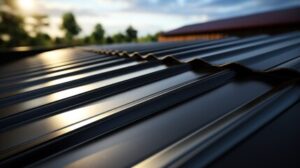If your roof is nearing or past its expected lifespan, a replacement should be considered. Look for rot, sagging, or interior water stains as well as moss, which indicate trapped moisture that could compromise the integrity of your home’s structure.
Repairs can only fix limited, localized damage, but elastomeric coatings may provide a durable solution that extends the lifespan of your roof. Visit http://www.fivestarroofingandcontracting.com/ to learn more.

Shingles are the roof’s outer layer of protection, so any cracking or missing ones can leave your home exposed to water damage. Missing and cracked shingles are the most obvious signs that your roof needs repair, but it’s important to keep an eye out for other telltale symptoms as well. For example, shingle discoloration or pattern inconsistencies can indicate problems beneath the surface, while a wavy appearance can signal that a shingle’s tabs have been bent past their capacity to flex.
A common cause of cracked shingles is wind damage, so it’s important to inspect your roof regularly after storms and any other extreme weather events. You should also be on the lookout for granule loss, which can indicate that your shingles are nearing the end of their lifespan. If you see a buildup of granules in your gutters or on the ground after it rains, it’s time to start thinking about replacing them.
To fix a cracked shingle, first make sure you’re safely on a ladder and wearing appropriate safety gear. Next, clean the area around the damaged shingle by loosening any debris with a brush or blower and making sure it’s dry; moisture can affect the adhesion of roofing cement. Once you’ve prepped the area, carefully lift a section of intact shingles above the damaged one with a pry bar. Once the shingle is loose, use the curved end of the pry bar to expose the row of nails that secure it and remove them. Then, slide the new shingle into place and nail it to the roof deck. To prevent future damage, you should consider adding a layer of roof cement to the exposed nail heads.
Cracked shingles can also develop as a result of thermal expansion and contraction, which causes the shingle to expand during the day and contract at night. This can cause the shingle to crack over time, and it’s important to inspect your roof regularly so that early signs of splitting are spotted and addressed before they become serious. If you see a shingle cracking, contact a residential roofing contractor for repair as soon as possible.
Damaged Flashing
Flashing is a durable piece of metal used to create a watertight seal around a roof’s most vulnerable areas. These include the joints where the roof meets a wall, chimneys and vent pipes, dormers, skylights, and roof valleys. It is usually made of rust-resistant metal (typically galvanized sheet metal) but can also be constructed from copper or aluminum. The flashing is secured with an adhesive or sealant to ensure that water does not penetrate the area. While a well-installed flashing will last for a long time, it can be damaged by serious weather conditions, age, or other factors. Damaged flashing must be repaired promptly to avoid costly roof damage.
A roofing professional can repair or replace the affected flashing, ensuring that it forms a watertight seal and prevents water infiltration. The repair process includes removing any debris or dirt from the damaged area, cleaning the surfaces and surrounding shingles, and applying a fresh layer of roof cement or caulking. For small gaps or cracks, a patching material may be used to fill the area.
When flashing is damaged, it can result in leakage in the attic and other parts of the home. If left untreated, moisture infiltration can lead to rot and mold, which may degrade the structure of the building, impact indoor air quality, and reduce energy efficiency. In addition, moisture infiltration can compromise insulation, resulting in higher energy costs.
Damaged flashing is often caused by severe storms that bend, dislodge, or tear the flashing from its position on the roof. However, it can also be the result of poor installation or regular wear and tear. In any case, the damaged flashing must be repaired immediately to prevent extensive damage and water infiltration.
Water leakage from faulty flashing can damage ceilings, walls, insulation, and furnishings in the home. It can also lead to a range of health problems, including mold growth and respiratory issues. Fortunately, most flashing damage can be prevented with a routine roof maintenance plan that includes inspections of the roof components. Contact a local roofer to perform an annual inspection of the flashing and other roof components.
Leaking Pipes
Leaking pipes are one of the most dangerous problems to ignore, as each drop of water can cause more damage over time. When left untreated, it can lead to severe structural issues and a cascade of expensive repairs. If you notice signs of a leaking pipe, such as damp spots on walls and ceilings or a musty smell, it’s important to call a plumber right away.
The first step in repairing a leaky pipe is to turn off the water supply and drain the affected area. Then, clean the area to remove dirt and debris and prepare the pipe for repair. If the leak is near electrical fixtures, fittings, cables, or other objects, you should turn off the power to those areas and use a noncontact electrical tester to ensure they are completely turned off. It’s also a good idea to wear protective gloves when working with the repair material.
There are a number of different ways to repair leaking pipes, depending on the type and severity of the leak. For small leaks, you can use pipe repair tape or a pipe clamp to prevent water from flowing out and damaging the surrounding area. These tools are available at most hardware stores, and they can provide a temporary fix until you can get a plumber to the site.
For larger leaks, you can try using a compound stick or epoxy putty to seal the area. These products are easy to use, but they can only provide a temporary solution. If you are concerned about the quality of these products, you can also buy commercial pipe bandage at most hardware stores. This product consists of resin-impregnated fiberglass tape that can withstand the flow of water without breaking down.
A professional plumber will be able to assess the extent of the leak, cut out and replace the damaged section of pipe, and weld or solder connections for a lasting seal. In addition, they can inspect your plumbing system for other potential problems and perform a complete inspection of your roof to identify any additional areas that need attention.
Damaged Underlayment
Underlayment, the layer beneath shingles and roofing material, is vital for protecting your roof deck from water damage. This secondary barrier can help prevent moisture penetration, especially in harsh winters and rainy springs when ice dams and melting snow can release trapped moisture. However, just like the primary roofing material itself, the underlayment can become damaged or wear out over time. It’s important to be aware of this risk and to recognize the warning signs to ensure it can continue its protective role for your home.
One of the most common indicators that underlayment is deteriorating is a visible deflection of your roof’s surface, known as sagging. This is caused when the underlayment absorbs too much moisture, resulting in structural damage. While this is a serious issue, it’s also easy to repair if caught early enough.
Another common indicator of underlayment damage is a sudden increase in energy bills without other apparent explanation. This can occur when the underlayment is no longer able to insulate your roof and your HVAC system has to work harder to maintain a constant temperature throughout your home.
Moisture penetration through damaged underlayment is often followed by the formation of mold and mildew in attics or upper floors of the house. These microorganisms thrive in damp environments and their presence typically triggers a musty smell. When left unaddressed, these issues can lead to water damage, wood rot and other serious structural problems that necessitate costly repairs.
